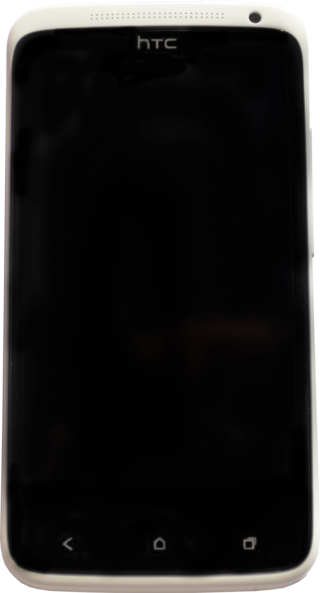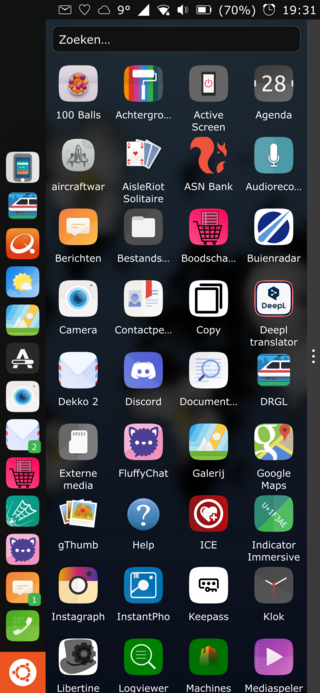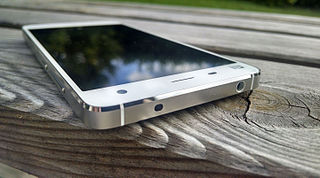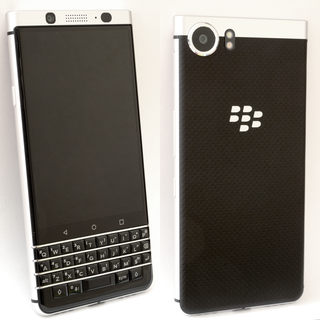Motorola Mobility LLC, marketed as Motorola, is an American consumer electronics manufacturer primarily producing smartphones and other mobile devices running Android. It is a subsidiary of the Chinese multinational technology company Lenovo.
Cherry Mobile is a Philippine mobile phone and electronics brand by Cosmic Technologies, established by Maynard Ngu in 2009. In 2010, barely two years after it started, Cherry Mobile was voted IT Company of the Year in the 3rd CyberPress Awards, upstaging some of the country's technology giants. The company imports mobile phones manufactured by original design manufacturers in China and markets them under the Cherry Mobile brand. Most of Cherry Mobile's current lineup come with Wi-Fi, capacitive touch screens and run on the Android, Windows, and Windows Phone operating systems; a line of smart feature phones running Firefox OS named Cherry Mobile Ace was also sold by the company for a time before it was later discontinued.

Lenovo smartphones are marketed as the "LePhone" in Mainland China and the "IdeaPhone" overseas. Motorola Mobility, ZUK Mobile and Medion, divisions of Lenovo, sell smartphones under their own brands. On April 27, 2017, Lenovo announced that the ZUK brand would cease operations. As of September 2015, Lenovo is in the process of rebranding most of its phones using the Motorola brand name.

The HTC One X is a touchscreen-based, slate-sized smartphone designed and manufactured by HTC. It was released running Android 4.0.3, with the HTC Sense 4.0 skin. The One X is powered by the NVIDIA Tegra 3 for most international GSM carriers, making this the first HTC phone to be equipped with a quad-core processor, while a variant which is LTE capable is powered by the Qualcomm Snapdragon S4 dual-core 1.5 GHz Krait processor. The One X was announced on February 26, 2012, at the Mobile World Congress and was HTC's sixth flagship product, leading the HTC One series from the time of its release through April 2013, when its successor the HTC One (M7) was announced.

Samsung Galaxy Ace 2 (GT-I8160) is a smartphone manufactured by Samsung that runs the Android operating system. Announced and released by Samsung in February 2012, the Galaxy Ace 2 is the successor to the Galaxy Ace Plus.

Ubuntu Touch is a mobile version of the Ubuntu operating system, being developed by the UBports community. Its user interface is written in Qt, and is designed primarily for touchscreen mobile devices such as smartphones and tablet computers, but the original goal of convergence was intended to bring Ubuntu Touch to laptops, desktops, IOT devices and TVs for a complete unified user experience.

Moto X is an Android smartphone developed and manufactured by Motorola Mobility, and released in August 2013.

The Nokia X family was a range of budget smartphones that was produced and marketed by Microsoft Mobile, originally introduced in February 2014 by Nokia. The smartphones run on the Nokia X platform, a Linux-based operating system which was a fork of Android. Nokia X is also known generally as the Nokia Normandy. It is regarded as Nokia's first Android device during the company's Microsoft partnership and was in the process of selling its mobile phone business to Microsoft, which eventually happened two months later.

The Nokia X2 is an entry-level smartphone which was announced and released by Microsoft Mobile on 24 June 2014. It is the successor of the Nokia X, being the first smartphone running version 2.0 of the Android-based Nokia X platform operating system. The Nokia X family of Android phones was discontinued on July 17, 2014.

The Xiaomi Mi 4 is a smartphone developed by the Chinese electronics manufacturer Xiaomi for its high-end smartphone line, and was released in August 2014. Xiaomi held an event to formally introduce the high-end phone, and its complementary smart-accessory, the Xiaomi MiBand, during the Xiaomi New Product Launch Event 2014 on 22 July 2014.

Redmi is a subsidiary company owned by the Chinese electronics company Xiaomi. It was first announced in July 2013 as a budget smartphone line, and became a separate sub-brand of Xiaomi in 2019 with entry-level and mid-range devices, while Xiaomi itself produces upper-range and flagship Xiaomi phones. Redmi phones use Xiaomi's MIUI user interface on top of Android. Models are divided into the entry-level Redmi, the mid-range Redmi Note, and the high-end Redmi K. The unrelated Mi A Android One series is positioned in the same market segment as Redmi devices, despite being part of the upper-range Xiaomi Mi lineup. The most significant difference from other Xiaomi smartphones is that Redmi uses less expensive components, allowing lower prices while retaining good specifications. In August 2014, The Wall Street Journal reported that in the second quarter of the 2014 fiscal year, Xiaomi had a market share of 14% of the China smartphone market; Redmi sales were attributed as a contributing factor toward this ranking.

The second-generation Moto G is an Android smartphone developed by Motorola Mobility. Released on September 6, 2014, it is a successor to the original Moto G released in 2013. The phone was initially aimed at developing markets, although it is also available in developed markets as a lower-cost option compared to other phones in its class.
Obi Worldphone, previously Obi Mobiles, is a Silicon Valley smartphone manufacturer founded in 2014 by Neeraj Chauhan, Shane Maine, Gordon McMillan, and John Sculley. Obi Worldphone manufactures smartphones aimed at the emerging markets rather than very competitive developed markets.
The Huawei Mate 9 is a high-end Android smartphone, designed and produced by Huawei as part of the Huawei Mate series. It was released on 3 November 2016. It was succeeded by the Huawei Mate 10 series, and later the Huawei Mate 20 series.

The BlackBerry KeyOne is a touchscreen-based Android smartphone with an integrated hardware keyboard that is manufactured by TCL Corporation under the brand name of BlackBerry Mobile. Originally known by its unofficial code name "Mercury", the KEYone was officially announced at Mobile World Congress in Barcelona on February 25, 2017. While earlier BlackBerry smartphones running Android exist, the KeyOne is the first Android-based BlackBerry with the iconic BlackBerry design. TCL executives termed the KeyOne as a success, mentioning 850,000 units being sold.
The Oppo Find X is the 2018 flagship smartphone from the Oppo Find series and was launched on 19 June 2018 in Paris by Oppo. The Find X features a different design from traditional smartphones, as it has a mechanic pop-up camera. The phone has a screen to body ratio of 87%, the thinnest bezels in the market when it launched, and is considered the first "all screen" smartphone to be released.

The Xiaomi Mi 5 (Chinese:小米手机5) is a smartphone developed by the Chinese electronics manufacturer company Xiaomi for its high-end smartphone line, released in February 2016. The Xiaomi Mi 5 has a 5.15-inch 1080p screen, a Snapdragon 820 processor, a 3,000-mAh battery and a Sony Exmor IMX 16-megapixel camera. The standard version has 3GB of RAM with 32GB of storage space (UFS2.0). The advanced version has the same amount of RAM with 64GB of storage space (UFS2.0). The premium edition has 4GB of RAM and 128GB of storage. It was released 528 days after the Xiaomi Mi 4 went on sale, and the Xiaomi Mi 5 was a long time coming after a flood of flagship phones from different brands.
The Samsung Galaxy A10s is an Android-based smartphone developed and marketed by Samsung Electronics as a part of its Galaxy A series. This phone was announced on August 27, 2019, and was targeted towards the low-budget category. It is the second Galaxy smartphone not manufactured by Samsung and was instead manufactured by Jiaxing Yongrui Electron Technology. Unlike the first ODM Galaxy smartphone, the China-exclusive Samsung Galaxy A6s, it is available internationally.
The iQOO 3 is an Android-based smartphone designed, developed and marketed by Vivo owned iQOO as a part of its iQOO gaming smartphone series. This phone was announced on February 25, 2019. The iQOO 3 was introduced as a premium segment smartphone with a special focus on gaming.











